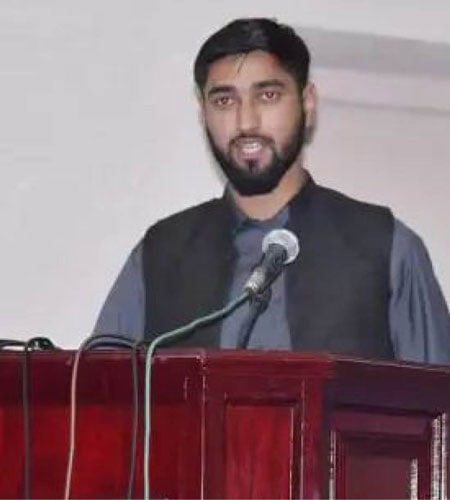Mohammad Umar Bhat
In May 2008, Indian backed government of Jammu and Kashmir transferred 99 acres of forest land to Amaranth Shrine Board in the occupied Kashmir valley to set up shelters for Hindus.
People of Jammu and Kashmir demonstrated against the land transfer and demanded revocation of the land transfer.
All the senior Hurriyat Conference leaders were placed under house arrest. The pressure from Hurriyat-led protests forced the Indian-backed Jammu and Kashmir governments to withdraw from the land transfer in July 2008.
RSS backed protest in the Jammu region The BJP and the RSS started to protests in Jammu region against the revocation of land transfer. RSS and BJP blocked the Jammu and Kashmir national highway – the only land route that connects occupied Kashmir with India.
Protestors blocked apple-laden trucks heading towards New Delhi, for annual sale, which resulted in a complete economic blockade of the Kashmir valley.
Soon Kashmir, whose economy mainly depends on agriculture and horticulture, felt the heat of the economic blockade.
Muslim homes were also burned by RSS and BJP goons in Jammu region. RSS goons also stopped trucks taking essential materials to Kashmir valley, with Kashmir witnessing a shortage of essential drugs and food.
Fruit growers of Sopore, a township in Baramulla district along the dividing Line of Control (LoC), gave a 24-hour ultimatum to the government to clear the blockade of the national highway.
As the harvesting season of apple and other fruits was at its peak, Sopore was severely suffering. Sopore has the second-largest Fruit Mandi in Asia.
Muzaffarabad call by Hurriyat Conference In the first week of August 2008, Hurriyat Conference called for “Muzaffarabad Chalo” on 11 August against economic blockade by the RRS and the BJP.
Half a million people marched from many parts of Kashmir towards Sopore and towards Uri – a town of Baramulla district along the LoC.
Sheikh Abdul Aziz, Shaheed Sheikh Abdul Aziz was born in a saffron yielding family in Pampore town of Kashmir valley. He rose to become a senior member of the Hurriyat Conference – an alliance of Kashmiri freedom movement fighting for the political solution against illegal Indian rule in Indian-occupied Jammu and Kashmir.
He headied his political group known as Jammu Kashmir Peoples League, strongly advocating the right of self-determination for solving the Kashmir dispute under the UN-supervised plebiscite.
From childhood, Shaheed Aziz hated occupation and was very vocal against Indian rule.
For this cause, he chose armed resistance to fight the Indian occupation. He was later arrested and put behind bars for several years, spending over 20 years in different jails and interrogation centers. After his release, he and other pro-freedom leaders formed the Hurriyat conference.
Shaheed Syed Ali Geelani described him as a visionary leader, Shaheed-e- Azeemat (Supreme sacrifice), who lived a very simple life. While as Kashmiri resistance leader Muhammad Yasin Malik described him as a man with a humble heart, a dedicated fighter who remained in the front row of the movement and sacrificed his life for the Kashmir cause.
Sheikh Abdul Aziz, along with other senior Hurriyat Conference members, joined the protest demonstration of fruit growers in Sopore and started marching towards Muzaffarabad. It is estimated that around 5 lakh people were marching towards Muzaffarabad, and Indian armed forces could not resist it.
After crossing Baramulla town, at Chala, near Uri, a group of armed Indian forces fired live bullets on unarmed demonstrators, killing at least 15 people, including Sheikh Abdul Aziz and injuring over 150. It triggered panic and the Kashmiri marches, who had come from across the Kashmir valley, dispersed during the night.
Aziz spent his last night in Sopore and delivered a historic speech at main chowk Sopore on 11 August before moving towards the LoC in Uri. Eye witnesses say Shaheed Aziz had tried to hold talks with Indian armed forces, who were firing live bullets on peaceful protestors but he himself was hit by a burst of fire in his abdomen, critically injuring him.
He was rushed to a hospital in Srinagar, where he breathed his last. Aziz was buried in the martyr’s graveyard in Srinagar on 12th August. Fifteen more people were martyred on 12th august in different parts of Kashmir valley.
The martyrdom of Sheikh Abdul Aziz proved to be the threshold to the new generation of Kashmir freedom struggle. The new generation of youth was motivated by the resilience of Sheikh Abdul Aziz. In the aftermath of his martyrdom, the government imposed strict curfew and restrictions on the movement of people. Sheikh Abdul Aziz is remembered as an unsung hero of the Kashmir freedom struggle.










